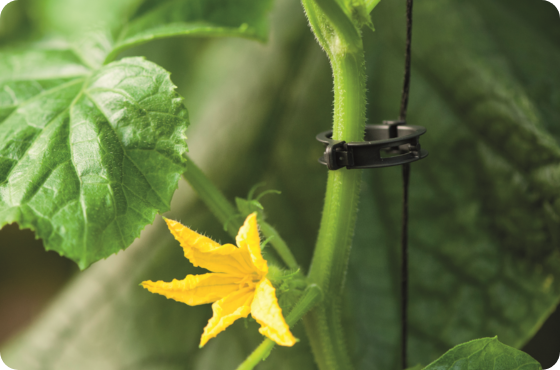Quality Products
Fast Delivery
Premium Service
Written by Martin Meuldijk, specialist Crop Rotation | Last update: 20. May 2022
Winding or clipping vine crops promotes upward growth and prevents the plants from collapsing under the crop's weight, like bell peppers or tomatoes. By tying them up with twine, the risk of kinks or tears in the plant is minimized, preserving the quality of the crop. Both winding and clipping are techniques aimed at achieving the same goal. The choice between them is influenced by several factors.

When it comes to choosing between winding and clipping for plants, there isn't a straightforward answer. While clipping is suitable for every crop, winding may not be suitable for plants with thick stems. However, thick stems can be seasonal, allowing for a combination of both techniques.
In terms of cost, there isn't a clear winner either. Winding tends to incur higher labour costs, whereas clipping involves dealing with potentially higher material and waste costs. Nonetheless, winding does carry some risks that could lead to increased damage costs. However, having highly experienced individuals performing winding can mitigate these risks. On the other hand, clipping doesn't require any prior experience, making it accessible to anyone without concerns about potential damage costs.
| Winding | Clipping | |
|---|---|---|
| Material costs | + | - |
| Labour costs | - | + |
| Expertise | + | - |
| Speed | - | + |
| Sustainability | + | - |
| Risk of plant damage | - | + |
| Growth delay | - | + |
Pros
Cons
Pros
Cons
Winding is a specialized method that can slow down plant growth because it involves "pinching" the stem, reducing nutrient supply. There is a risk of harming the plant if done incorrectly. Winding typically progresses at a slower pace compared to clipping. During winding, minimizing movement of the plant's head is crucial. You support the plant's weight and then twist the twine around the stem while gently guiding the leaves upward with your free fingers.
Avoid wrapping the twine around each leaf of a tomato plant, especially if there are kinks in the stem. This can lead to breaking the plant's head or causing considerable damage to its cells.
When clipping, you attach a clip to the plant and twine without winding the plant. The major advantage here is that, unlike winding, you do not compress the plant's stem, thus avoiding any growth delay.
Proper clip placement is essential; it should always be positioned under the leaf, never directly above or below a growing leaf due to its strength. In the case of cucumbers, it goes just below the leaf. Clipping cucumbers has the added benefit of not requiring a tight twist to prevent the stem from slipping.
Some crops, particularly those with thick stems, are prone to breaking if you use the winding technique. In such cases, it is preferable to clip these crops instead of winding them.
Influence of Daylight
Day length, and consequently the amount of daylight received by the plant, affects stem thickness. During cold winters with short days, crop stems tend to be thicker. As spring and summer bring longer daylight hours, plants experience increased length growth. Therefore, winding may be suitable in spring and summer, while clipping is preferable during colder periods.
Did you know: Every additional hour of light results in an average of 1% more growth.
Regulating Growth with LED Lighting
Assimilation or LED lighting can control light exposure, extending the natural daylight period and influencing plant growth (including stem thickness). Alongside irrigation, heat, CO2, and crop treatments, assimilation lighting plays a vital role in plant growth, affecting decisions regarding clipping and winding techniques. Explore more about selecting assimilation lights or maintaining your grow light installation for optimal results.
There is a noticeable trend among growers towards choosing clipping over winding. This shift primarily stems from the labour and expertise required. Winding is typically performed by trained employees, whereas clipping can be done by anyone without specialized training. Finding employees skilled in winding is becoming increasingly challenging, and winding also entails higher labour costs. Explore our range of tomato stem support clips and easily request a quotation. Unsure about which clips to use? Our specialists would like to help you!
Both techniques offer distinct advantages. You don't have to pick one over the other; instead, you can combine them. One advantage of this approach is the ability to steer the crop either generatively or vegetatively.
Generative Stimulus through Winding
If you have vegetative plants but wish to encourage more fruit production, winding is the solution. Winding induces a kind of "pain" in the plant, triggering a stress response that leads to increased fruit production.
Vegetative Stimulus through Clipping
Conversely, if you have generative plants and want to promote vegetative growth, clipping is the preferred method.
Opting for sustainability? Then winding is a viable option. Unlike clipping, winding doesn't involve material costs or resulting waste costs. However, there is now a growing market for biodegradable clips. Learn more about the pros and cons of bio clips.